The vinegar market, valued at USD 11.3 billion in 2025, is expected to reach USD 17.3 billion by 2035, with a CAGR of 4.4%. From 2021 to 2025, the market is expected to grow steadily from USD 9.1 billion to USD 11.3 billion, with incremental increases reaching USD 9.5 billion, USD 9.9 billion, USD 10.3 billion, and USD 10.8 billion. This early phase reflects moderate growth, driven by increasing demand for vinegar in food and beverage applications, particularly in dressings, marinades, and pickling, as consumers become more health-conscious. Vinegar's potential health benefits, such as aiding digestion and promoting weight management, also contribute to its growing popularity as a natural ingredient.
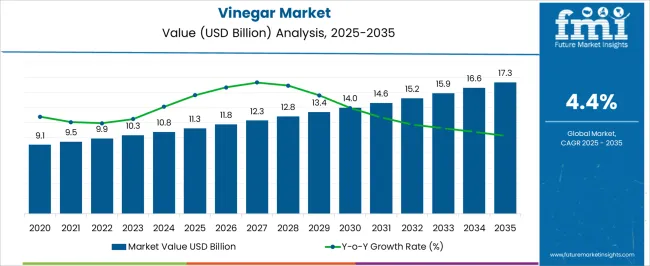
Between 2026 and 2030, the market accelerates, expanding from USD 11.3 billion to USD 14.0 billion, passing through USD 11.8 billion, USD 12.3 billion, USD 12.8 billion, and USD 13.4 billion. This period shows stronger growth, fueled by innovation in product offerings, including organic, flavored, and health-oriented vinegars. The trend toward clean-label, natural ingredients continues to gain momentum, further driving the adoption of vinegar in diverse culinary applications. From 2031 to 2035, the market is projected to reach USD 17.3 billion, progressing through values of USD 14.6 billion, USD 15.2 billion, USD 15.9 billion, and USD 16.6 billion.
| Metric | Value |
|---|---|
| Vinegar Market Estimated Value in (2025 E) | USD 11.3 billion |
| Vinegar Market Forecast Value in (2035 F) | USD 17.3 billion |
| Forecast CAGR (2025 to 2035) | 4.4% |
The food and beverage market is the largest contributor, accounting for approximately 40-45% of the market. Vinegar is a key ingredient in cooking, food preservation, and salad dressings, contributing significantly to its widespread use in households, restaurants, and food processing. The health and wellness market contributes around 20-25%, as vinegar, particularly apple cider vinegar, is increasingly popular as a health tonic, with claims related to weight management, digestive health, and blood sugar regulation, driving its use in dietary supplements and health-focused products.
The cosmetics and personal care market holds about 15-18%, with vinegar being used in various skincare and haircare products due to its beneficial properties for cleansing, exfoliating, and balancing pH levels in personal care formulations. The household products market is expected to grow by approximately 10-12%, as vinegar is commonly used as a natural cleaning agent due to its disinfecting properties and non-toxic nature, making it a popular choice for eco-friendly cleaning solutions. The industrial applications market contributes around 5-8%, where vinegar is used in food processing, pickling, and certain manufacturing processes, such as the textile industry for dyeing and finishing.
The vinegar market is witnessing steady expansion, supported by increasing demand across culinary, industrial, and health-oriented applications. Market growth is being reinforced by the rising adoption of vinegar in food preservation, flavor enhancement, and as a natural cleaning agent. The current scenario reflects heightened interest in vinegar’s functional benefits, including its perceived role in digestion support and blood sugar regulation, which has bolstered its positioning in the health and wellness space.
Expanding urbanization and the popularity of convenience cooking have further driven vinegar consumption across retail and foodservice channels. On the supply side, advancements in fermentation processes and diversified sourcing strategies have improved both product quality and variety.
The market outlook remains positive, with growth expected to be propelled by consumer preference for natural and multipurpose ingredients, the incorporation of vinegar in value-added condiments, and the development of organic and specialty varieties.
The vinegar market is segmented by product type, source, flavor, and geographic regions. By product type, vinegar market is divided into White vinegar, Apple cider vinegar, Balsamic vinegar, Red Wine vinegar, Rice vinegar, Sushi vinegar, and Others. In terms of source, vinegar market is classified into Organic and Synthetic. Based on flavor, vinegar market is segmented into Plain/traditional vinegar, Herb-infused vinegar, Fruit-infused vinegar, and Other. Regionally, the vinegar industry is classified into North America, Latin America, Western Europe, Eastern Europe, Balkan & Baltic Countries, Russia & Belarus, Central Asia, East Asia, South Asia & Pacific, and the Middle East & Africa.
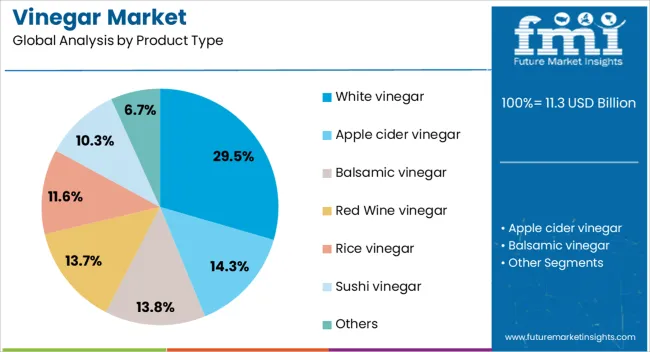
The white vinegar segment accounts for approximately 29.5% of the vinegar market, securing its position as a leading product type. This share is driven by its broad applicability across food preparation, preservation, and household uses. Its neutral color, consistent acidity, and relatively low production cost have contributed to widespread acceptance across both retail and industrial segments.
The segment benefits from strong demand in pickling, salad dressings, marinades, and commercial food processing where clarity and mild flavor are desired. Growth has been supported by its versatility, allowing it to cater to both traditional culinary practices and modern packaged food requirements.
White vinegar also remains a preferred choice in cleaning products due to its effective antimicrobial properties. As manufacturers focus on sustainable production and improved packaging formats, white vinegar is expected to maintain stable demand, reinforcing its long-standing role in the vinegar category.
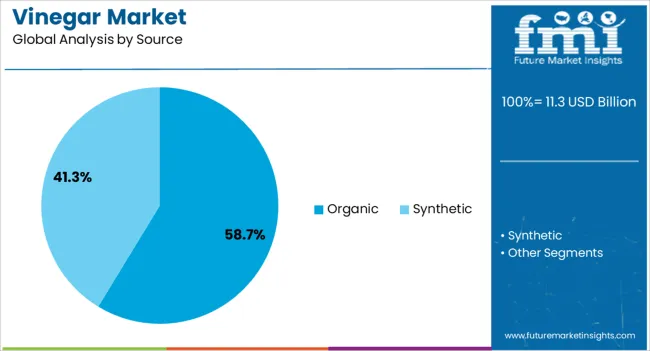
The organic segment leads the source category, holding a market share of approximately 58.7%. Its growth is being reinforced by the escalating demand for clean-label products and consumer preference for ingredients free from synthetic pesticides or additives. The segment benefits from expanding health-conscious demographics and increased purchasing power, particularly in premium retail channels.
Organic vinegar production aligns with broader sustainability trends, catering to consumers seeking traceable and environmentally responsible sourcing. Additionally, organic certification has enabled producers to access niche markets with higher margins, including specialty food stores and export-oriented channels.
The perceived health benefits associated with organic products have further amplified market interest, strengthening loyalty among repeat buyers. As awareness of organic farming practices continues to spread and regulatory frameworks support its labeling integrity, the organic vinegar segment is poised to sustain its leadership position in the forecast period.
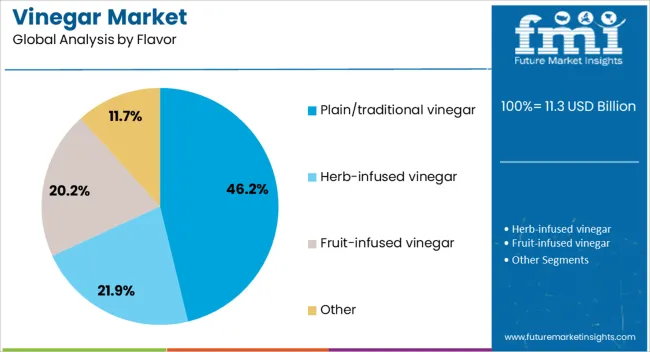
The plain/traditional vinegar segment holds approximately 46.2% of the flavor category, reflecting enduring consumer preference for familiar taste profiles. Its prominence is attributed to versatility in culinary applications, from basic seasoning to use as a cooking ingredient across diverse cuisines. The segment benefits from a cost advantage compared to flavored or infused varieties, making it highly competitive in price-sensitive markets.
Demand is supported by established consumption patterns in households and foodservice establishments, where plain vinegar serves as a staple ingredient for both cooking and preservation. In industrial applications, its consistent acidity and flavor stability contribute to its preference over more complex formulations.
The segment has also maintained resilience against fluctuating flavor trends, given its status as a base product in vinegar production. With ongoing demand in both mature and emerging markets, plain/traditional vinegar is expected to remain a core offering within the flavor category over the long term.
Vinegar is increasingly used for culinary purposes, as well as for its health benefits, such as digestion support and weight management. The market is also driven by the growing popularity of organic and specialty vinegars, including apple cider vinegar and balsamic vinegar, which are gaining attention for their unique flavors and health benefits. Challenges include fluctuations in raw material prices, such as the cost of raw fruits and grains, as well as increasing competition from alternative products like lemon juice and citric acid. Opportunities are emerging in the health and wellness sector, with increasing consumer interest in functional food and beverages. Trends indicate a rise in demand for flavored vinegars, innovative packaging, and clean-label products.
The vinegar market is being driven by growing consumer interest in organic, specialty, and health-conscious vinegar options. Organic apple cider vinegar and balsamic vinegar are gaining popularity due to their perceived health benefits, including digestive aid and weight management properties. Additionally, as consumers become more health-conscious, they are increasingly seeking out vinegars with functional health benefits, such as low-calorie content and probiotic properties. The rise in wellness trends, particularly in the food and beverage sector, is boosting demand for vinegars that cater to these needs. This shift towards healthier and more natural food ingredients is fueling the growth of the vinegar market, particularly in the organic and specialty segments.
The price of raw materials, including apples for apple cider vinegar and grapes for balsamic vinegar, can significantly impact overall production costs. Supply chain disruptions, especially during peak harvest periods, can affect availability and increase costs. Regulatory pressures related to labeling, health claims, and food safety standards further complicate the market. Manufacturers must ensure that their products meet both regional and international regulations, including quality certifications for organic and health-focused products. Technological constraints, such as the need for fermentation and aging processes, also add complexity to production.
Vinegar, particularly apple cider vinegar, is being marketed for its digestive and weight management benefits, tapping into the growing health and wellness trends. There is also a rising interest in flavored vinegars, which are being used to create new culinary experiences. Flavored vinegars, including herbs, fruits, and spices, offer consumers an innovative and versatile product for cooking and dressing. The clean-label trend, where consumers seek products with simple, natural ingredients and no artificial additives, is driving growth in organic and naturally fermented vinegars. Suppliers that focus on these emerging trends are positioned to capitalize on the growing demand for health-driven and creative vinegar products.
The vinegar market is witnessing trends that focus on incorporating functional ingredients, eco-friendly packaging, and premium products. With the increasing focus on health, consumers are seeking vinegar products that offer added functional benefits, such as probiotics, antioxidants, and antimicrobial properties. There is also a growing demand for eco-friendly packaging, as consumers become more environmentally conscious and prefer sustainable options. Premium products, such as aged or barrel-fermented vinegars, are gaining traction in the market as consumers look for unique and high-quality offerings. As consumer preferences evolve, manufacturers are expected to innovate with new flavors, ingredients, and packaging options to meet these emerging demands.
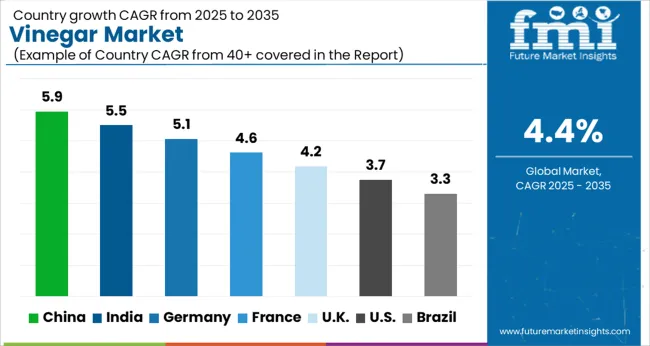
| Country | CAGR |
|---|---|
| China | 5.9% |
| India | 5.5% |
| Germany | 5.1% |
| France | 4.6% |
| UK | 4.2% |
| USA | 3.7% |
| Brazil | 3.3% |
The global vinegar market is projected to grow at a CAGR of 4.4% from 2025 to 2035. China leads the market with a CAGR of 5.9%, followed by India at 5.5%, and Germany at 5.1%. The UK and USA are expected to grow at 4.2% and 3.7%, respectively. The market is driven by the growing health consciousness among consumers, the rise in gourmet food trends, and the increasing use of vinegar in food preservation and cooking. The demand for organic and natural vinegar varieties, along with its emerging health benefits, is expected to further fuel growth in these regions. The analysis spans over 40+ countries, with the leading markets shown below
The vinegar market in China is expected to grow at a CAGR of 5.9% from 2025 to 2035, driven by the growing popularity of traditional Chinese vinegars and the increasing demand for international varieties. The increasing consumption of vinegar in food and beverage applications, especially in cooking and as a preservative, is a key driver. China’s rich culinary history, which integrates various types of vinegar like black vinegar, is contributing to higher demand, both domestically and in export markets. The health benefits associated with vinegar, such as digestive and detoxifying properties, are gaining attention among Chinese consumers, further boosting market growth. With China’s expanding middle class and increasing urbanization, the demand for convenient and diverse food products, including vinegar, is on the rise. The growing trend of global culinary fusion and increasing Western influence in food preferences is also creating demand for different types of vinegars.
The vinegar market in India is set to grow at a CAGR of 5.5% from 2025 to 2035, driven by increasing health awareness and the expansion of vinegar’s application in cooking and food preservation. Traditional uses of vinegar, such as in pickling and as a souring agent in Indian cuisines, continue to drive its consumption. With rising disposable incomes and a shift in consumer preferences toward international food flavors, the demand for various types of vinegars, including apple cider and balsamic vinegar, is growing. Vinegar is also gaining recognition for its potential health benefits, such as blood sugar regulation and digestion improvement. The increasing awareness of natural and preservative-free food products is further driving vinegar adoption in India.The rapid expansion of modern retail and e-commerce platforms has made vinegar more accessible to urban populations, contributing to the market’s growth.
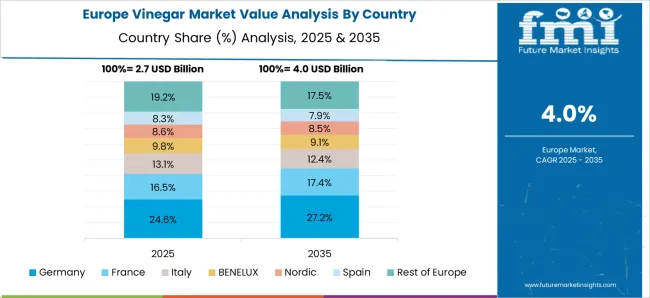
The vinegar market in Germany is projected to grow at a CAGR of 5.1% from 2025 to 2035. The German market is influenced by the growing trend of healthy eating and the increasing use of vinegar in both food and beverages. Traditional German vinegar, such as apple vinegar, remains a staple in local cuisines, but the demand for more specialized vinegars, like balsamic and white wine vinegar, is also rising. The increasing focus on natural, organic products and the growing demand for products free from artificial preservatives are fueling vinegar consumption in Germany. Vinegar is gaining popularity in wellness circles for its potential health benefits, such as aiding digestion and detoxifying the body. Germany’s robust food processing industry is also driving the need for vinegar in large quantities for food manufacturing and preservation.
The vinegar market in the UK is expected to grow at a CAGR of 4.2% from 2025 to 2035. Vinegar in the UK is primarily used in cooking, salad dressings, and pickling, with an increasing interest in healthy and organic food products. There is also a growing demand for gourmet vinegars, such as balsamic and apple cider vinegar, driven by consumer trends toward high-quality and unique culinary experiences. The growing awareness of vinegar’s potential health benefits, including its ability to support weight loss and improve digestion, is further boosting its consumption in the UK The increasing popularity of plant-based diets and natural food products in the country is also driving the demand for vinegar as a versatile and healthy ingredient.
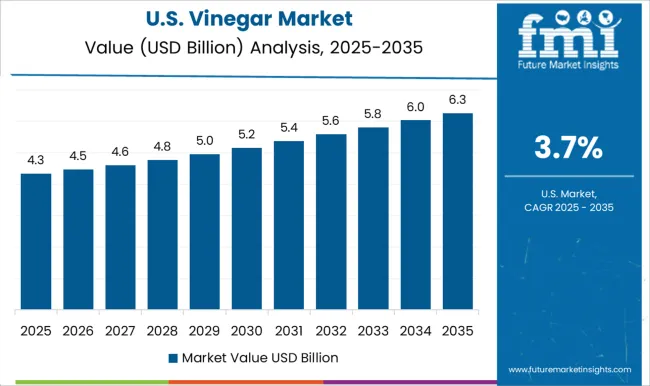
The USA vinegar market is expected to grow at a CAGR of 3.7% from 2025 to 2035, with a shift toward healthier lifestyles and an increasing use of vinegar for its various health benefits. Vinegar consumption in the USA is growing due to its use as a staple ingredient in salad dressings, marinades, and as a natural preservative. Vinegar’s popularity as a functional food ingredient for weight management, blood sugar regulation, and digestive health is also driving demand. Furthermore, the increasing adoption of plant-based diets and interest in natural, organic products is contributing to the market’s growth. The expansion of e-commerce and retail outlets offering diverse vinegar varieties has also made these products more accessible to USA consumers, stimulating market expansion.
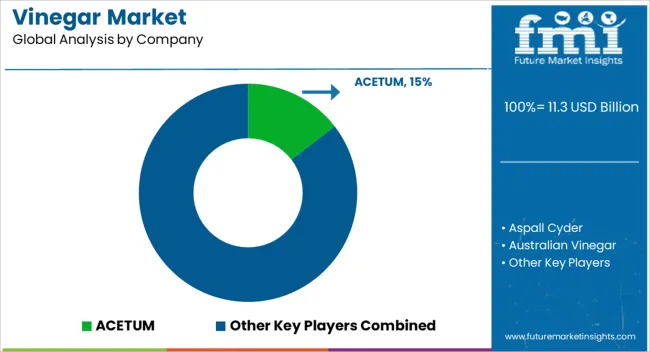
In the vinegar market, competition is defined by product innovation, flavor variety, and quality, catering to both culinary uses and health-conscious consumers. ACETUM stands out with its premium vinegar products, offering a range of balsamic and wine vinegars known for their rich flavors and aging processes. The company focuses on high-quality production methods and premium offerings targeted at both the retail and foodservice sectors. Aspall Cyder, a recognized player in the apple cider vinegar segment, competes with a focus on organic and craft vinegar varieties, emphasizing traditional production methods and premium ingredients for a premium, artisanal appeal. Australian Vinegar competes by offering a variety of vinegars made from locally sourced ingredients, with a strong focus on high-quality, natural production methods.
Their products are widely distributed in the Australian market and emphasize sustainability and organic certifications. Burg Groep provides a diverse portfolio of vinegars, including balsamic, fruit, and specialty vinegars, with an emphasis on providing consistent quality for the food industry and retail markets. The company focuses on blending traditional production methods with modern processing technologies for reliable products at scale. Carl Kühne and Castelo Alimentos compete by offering a broad range of vinegar types, including white, balsamic, and apple cider vinegars, focusing on providing accessible products for both consumer and industrial uses.
Charbonneaux-Brabant is a significant player in the European market, known for its specialized vinegar products for the foodservice and industrial sectors. De Nigris, a leader in balsamic vinegar, is known for its premium offerings, targeting the high-end culinary market with a focus on authenticity, quality, and flavor innovation. Eden Foods and Fleischmann's Vinegar Company cater to the growing demand for organic and natural vinegars, offering products designed for health-conscious consumers. Galletti and Marukan Vinegar are key competitors offering high-quality vinegar for a range of culinary applications, with Marukan focusing on traditional Japanese rice vinegar production.
| Item | Value |
|---|---|
| Quantitative Units | USD 11.3 Billion |
| Product Type | White vinegar, Apple cider vinegar, Balsamic vinegar, Red Wine vinegar, Rice vinegar, Sushi vinegar, and Others |
| Source | Organic and Synthetic |
| Flavor | Plain/traditional vinegar, Herb-infused vinegar, Fruit-infused vinegar, and Other |
| Regions Covered | North America, Europe, Asia-Pacific, Latin America, Middle East & Africa |
| Country Covered | United States, Canada, Germany, France, United Kingdom, China, Japan, India, Brazil, South Africa |
| Key Companies Profiled | ACETUM, Aspall Cyder, Australian Vinegar, Burg Groep, Carl Kühne, Castelo Alimentos, Charbonneaux-Brabant, De Nigris, Eden Foods, Fleischmann's Vinegar Company, Galletti, and Marukan Vinegar |
| Additional Attributes | Dollar sales by product type (balsamic, apple cider, wine, rice, white, other flavored varieties), end-user segment (household, foodservice, industrial), and distribution channel (retail, online, foodservice). Demand dynamics are driven by increasing consumer preference for healthy, natural, and organic food options, growing use of vinegar in cooking and as a food preservative, and rising awareness of the health benefits of apple cider and organic vinegars. Regional growth is strong in North America, Europe, and Asia-Pacific, driven by culinary trends, expanding consumer interest in health and wellness, and innovations in flavored and specialty vinegar products. |
The global vinegar market is estimated to be valued at USD 11.3 billion in 2025.
The market size for the vinegar market is projected to reach USD 17.3 billion by 2035.
The vinegar market is expected to grow at a 4.4% CAGR between 2025 and 2035.
The key product types in vinegar market are white vinegar, apple cider vinegar, balsamic vinegar, red wine vinegar, rice vinegar, sushi vinegar and others.
In terms of source, organic segment to command 58.7% share in the vinegar market in 2025.






Our Research Products

The "Full Research Suite" delivers actionable market intel, deep dives on markets or technologies, so clients act faster, cut risk, and unlock growth.

The Leaderboard benchmarks and ranks top vendors, classifying them as Established Leaders, Leading Challengers, or Disruptors & Challengers.

Locates where complements amplify value and substitutes erode it, forecasting net impact by horizon

We deliver granular, decision-grade intel: market sizing, 5-year forecasts, pricing, adoption, usage, revenue, and operational KPIs—plus competitor tracking, regulation, and value chains—across 60 countries broadly.

Spot the shifts before they hit your P&L. We track inflection points, adoption curves, pricing moves, and ecosystem plays to show where demand is heading, why it is changing, and what to do next across high-growth markets and disruptive tech

Real-time reads of user behavior. We track shifting priorities, perceptions of today’s and next-gen services, and provider experience, then pace how fast tech moves from trial to adoption, blending buyer, consumer, and channel inputs with social signals (#WhySwitch, #UX).

Partner with our analyst team to build a custom report designed around your business priorities. From analysing market trends to assessing competitors or crafting bespoke datasets, we tailor insights to your needs.
Supplier Intelligence
Discovery & Profiling
Capacity & Footprint
Performance & Risk
Compliance & Governance
Commercial Readiness
Who Supplies Whom
Scorecards & Shortlists
Playbooks & Docs
Category Intelligence
Definition & Scope
Demand & Use Cases
Cost Drivers
Market Structure
Supply Chain Map
Trade & Policy
Operating Norms
Deliverables
Buyer Intelligence
Account Basics
Spend & Scope
Procurement Model
Vendor Requirements
Terms & Policies
Entry Strategy
Pain Points & Triggers
Outputs
Pricing Analysis
Benchmarks
Trends
Should-Cost
Indexation
Landed Cost
Commercial Terms
Deliverables
Brand Analysis
Positioning & Value Prop
Share & Presence
Customer Evidence
Go-to-Market
Digital & Reputation
Compliance & Trust
KPIs & Gaps
Outputs
Full Research Suite comprises of:
Market outlook & trends analysis
Interviews & case studies
Strategic recommendations
Vendor profiles & capabilities analysis
5-year forecasts
8 regions and 60+ country-level data splits
Market segment data splits
12 months of continuous data updates
DELIVERED AS:
PDF EXCEL ONLINE
Competitive Overview of Vinegar and Vinaigrette Companies
Vinegar and Vinaigrette Market Analysis by Cava Vinegar, Honey Vinegar, Red Wine Vinegar and Others Through 2035
United Kingdom Vinegar and Vinaigrette Market Insights – Demand & Forecast 2025–2035
United States Vinegar and Vinaigrette Market Insights – Demand & Forecast 2025–2035
Market Share Breakdown of Wood Vinegar Manufacturers
Wood Vinegar Market by Pyrolysis Method, End User Application & Region and Distribution Channel
Europe Vinegar and Vinaigrette Market Outlook – Growth, Demand & Forecast 2025–2035
United Kingdom Wood Vinegar Market Insights – Growth, Trends & Forecast 2025–2035
United States Wood Vinegar Market Analysis – Trends, Growth & Forecast 2025–2035
Apple Cider Vinegar Market Analysis - Size, Share, and Forecast Outlook 2025 to 2035
Europe Wood Vinegar Market Analysis – Demand, Size & Forecast 2025–2035
Asia Pacific Vinegar and Vinaigrette Market Insights – Growth, Demand & Forecast 2025–2035
Asia Pacific Wood Vinegar Market Analysis – Demand, Size & Forecast 2025–2035

Thank you!
You will receive an email from our Business Development Manager. Please be sure to check your SPAM/JUNK folder too.
Chat With
MaRIA